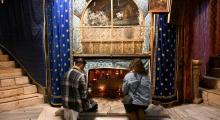Issued by the Catholic Center for Studies and Media - Jordan. Editor-in-chief Fr. Rif'at Bader - موقع أبونا abouna.org

Following is the text of the meditation of Latin Patriarch of Jerusalem His Beatitude Pierbattista Pizzaballa for the second Sunday of Easter, Year B, April 11, 2021:
The chapters of John’s Gospel that precede the arrest of Jesus deal with a lengthy dialogue between Jesus and His disciples: almost five chapters, from 13-17, and they help us to see the profound relationship that exists between them. Jesus speaks, tells, recounts his experience, informs them in advance of what is going to happen. He tells them about the Father and the Spirit, but He also speaks of how the life of the disciples will be in the world, after His departure. In short, a very intimate dialogue which depicts a deep relationship.
Then came the death of Jesus, the Cross, and this relationship was interrupted, the dialogue became silent, there were no more words between them: the Master failed, and the disciples were dispersed.
Appearing to His own, after the resurrection, Jesus therefore resumed, patiently and gradually, in a new way, His relationship with the disciples. Actually, we find ourselves confronted by a fragmented community: at the moment when the Lord arrives, someone is missing, the community is incomplete. So the Lord returns because community is precisely where everyone experiences resurrection, all encounter the Lord, no one is excluded.
Nor is it enough that there are others telling about it: this experience can only be personal. And a personal experience of faith cannot happen except within the community, together with others who walk with me in faith.
To understand what this experience consists of, we turn to the Gospels of Lent, where Jesus already told us that to believe it is necessary to look: taking a hint from the episode of the serpent in the desert (Num 21:4-9, cf. IV Sunday of Lent), He said that to recover from the evil of death it is necessary to be able to lift up one’s gaze, to see in the crucified Son of Man the infinite love of the Father, Who reaches us where we are, in our condition of death. Healing is for everyone, but only those who lift up their gaze gain access to it, because healing is the very relationship with the Lord Who saves.
In today’s Gospel, it is really the same thing. The Lord is risen, and He is life and peace for all. But only those who come into real contact with Him can access His own Risen Life.
Thomas needs to go from incredulity to faith: “do not be unbelieving, but believe,” Jesus says to him (Jn 20:27). But this step is not possible except by touching with one’s own hands, with one’s own life, the wounds of the Risen Lord, namely the mystery of love that is completed in the Paschal Mystery. That Mystery for which the Lord gave His life, and now is lives again among His own, because the love with which He love never fails. As the relationship between Jesus and the Father is an unshakeable relationship, so too that between Jesus and His disciples: this is the Paschal Mystery, Easter, and this is what Thomas needs to see, to know, to encounter.
For this reason, the Lord offers him His wounds, which do not disappear after the resurrection: the Risen One is the He Who is alive to be able to love us as crucified, by continuing to give life for us as when He was on the Cross. He is a continuous and eternal self-giving.
Experiencing Him must go through these wounds, no longer only looking at them from the outside, but in some ways going into them: “Take your hand and put it in my side” (Jn 20:27), touching the flesh of His love. Now, the dialogue goes through the wounds, a memorial of a love crucified and risen.
When this contact happens, then the Lord becomes my Lord: “My Lord and my God!” (Jn 20:28). In the Gospels, there are those who acknowledge that Jesus is the Son of God, and there are different professions of faith: but only Thomas, after seeing the glorious wounds, can say that this Lord is his Lord, this God is his God. Now he has experienced it, he regained the relationship with Him.
Jesus says that this touching no longer goes through seeing, but through faith (Jn 20:29), through the experience of feeling welcomed within His wounds. And this is possible for everyone.
It does not happen once and forever in life, because friendship needs to be nourished.
This experience, in the Church, has the rhythm of the eighth day, of Sunday, where the Lord appears again and welcome us into His wounds of love: the Eucharistic celebration is the place of contact, intimate and faithful, where the relationship becomes one of familiarity, confidence, and true friendship; where every Christian, together with his/her brothers/sisters, can say the same words of Thomas: “My Lord and my God!”
+Pierbattista







